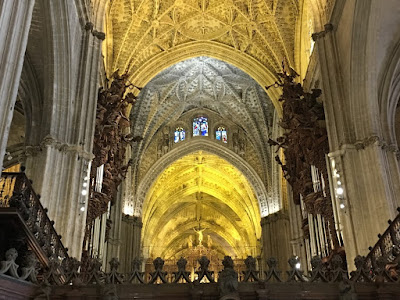I shouldn't complain about jet lag or coming home to 2 feet of snow. I still remember the sweet smell of bitter orange trees (perfect for making marmelade) that we found everywhere in Seville. We walked along the streets of Seville, enchanted by the sight and smell of these oranges everywhere.
 |
| Oranges in Courtyard, Cathedral of Seville |
Today, I'm remembering our visit to the incredibly large Cathedral of Seville, about 250,000 square feet and completed sometime early in the 16th Century, building on the bones of a mosque from the 12th Century. This massive Gothic church is divided into sections, each with its own altar. Worshipers mingle with tourists, all awed by the scope and majesty of the art and architecture here.
 |
| Cathedral of Seville, with bell tower on the right |
 |
| Main Altar, Seville Cathedral |
This Cathedral is large and complicated, with over 80 altars, each with its own saint and personality.
The main altar is stunning. A Flemish artist, Pierre Dancart, began working on the gilded gold reliefs in 1482, and it took him about 44 years to finish these reliefs that show scenes from the Old Testament and the lives of the saints.
Luckily for us, the large grill gates that separated the altar from the people were open, allowing me to take this picture.
One of my favorite parts of the Cathedral was the massive organ. Here is the view from the choir looking up to the ceiling and the organ itself.
 |
| Detail of Cathedral Organ |
We actually walked 315 feet up a sloping brick tunnel to the top of the Giralda (bell tower). Yes, the bell rang while we were up there! The view was stunning, as was the sense that this bell tower was once a minaret calling people to worship during the time of the Moors.
 |
| View from Giralda (Bell Tower) |
What I remember most about the Cathedral of Seville is that each generation built upon the bones of the previous generation over a period of nearly 1,000 years. Several guides talked to us about how Christians, Moors, and the Jews lived in harmony -- at least until 1492. Religious leaders used their power and lavish wealth to repair the damages of earthquakes and to build anew altars and burial tombs, almost a living history.
As we rested by the fountain in the Orange Courtyard, we were more than ready to sit in one of the many sidewalk cafes to enjoy a small cup of
cafe con leche (espresso coffee with milk).
Perhaps you will enjoy a few more highlights of our trip to Seville. Check back in a few days! Thank you for visiting.






No comments:
Post a Comment